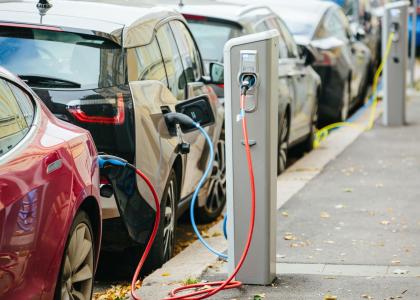An emerging accounting method can help companies assess the emissions impacts from consumers using their products. Two new publications show how the calculations can be done and demonstrate the value of the approach.
Information and communication technology- (ICT) based solutions hold great potential to reduce carbon emissions, but quantifying the reductions can be difficult, especially downstream of the technology companies that deploy them. An ACEEE report and white paper published today examine an approach for estimating these emissions reductions—the carbon handprint—and demonstrate calculations for several applications.
To understand the importance of a carbon handprint, consider the climate impact of a smart thermostat that can automatically adjust a home’s temperature settings. The emissions produced in making, powering, and disposing of the smart thermostat are its carbon footprint, but that calculation does not tell you about the thermostat’s impact on emissions from heating and cooling the home—in particular, its benefit—compared to a traditional thermostat.
A handprint—the difference between the emissions of a baseline or business-as-usual scenario (the lifecycle emissions of the home using a traditional thermostat) and the emissions of a solution (the home's emissions using the smart thermostat)—provides a more comprehensive understanding of a company's total emissions impacts than a footprint alone. We still need the carbon footprint to understand the emissions directly caused by a technology, but the handprint can reveal impacts enabled by the incorporated technologies or strategies.
Today’s studies, which build on a 2022 ACEEE white paper that provides a qualitative analysis of handprints, present concrete steps to measure handprints. We focus on ICT solutions—which we define as all technologies that enable the collection, storage, and use of data to optimize complex systems—and test models of three high-impact applications. Our report considers smart thermostats, while our white paper examines grid management at utility substations and electric vehicle fleet charging. These ICT solutions are examples of intelligent efficiency, which uses some of the most influential technologies of the past two decades to reduce energy consumption and greenhouse gas emissions.
These case studies provide proof of concept: Handprint calculation is possible and can provide a more holistic understanding of emissions. As more companies begin calculating handprint impacts, companies and customers will be able to make better-informed decisions about developing or buying products and services that reduce emissions.
Electric vehicle fleet charging optimization
The Biden administration has set a goal of ensuring all new heavy-duty vehicle sales are fully net-zero by 2040. While battery electric vehicles (EV) will be important to achieving this target, charging EVs will lead to meaningful new electric load on the grid, straining existing infrastructure and assets. ICT has the potential to help by optimizing the use of grid resources, and calculating the carbon handprint can tell us the scope of the emissions impact.
We investigated an ICT solution that improves the efficiency of depot charging of EVs used in short-haul freight and drayage fleets by helping schedule charging during peak periods. We analyzed the handprint by comparing the solution to both non-optimized charging and (to include some of the impacts of vehicle electrification) to diesel vehicles traveling an equivalent distance to the charged EVs.
Our analysis found that the ICT solution enables increased GHG savings through handprint of approximately 10% over non-optimized charging. Much higher values are possible depending on marginal hourly emissions. Compared to diesel vehicles, we found the handprint impact to be as high as 30-50%.
Grid management solution
Utilities with emissions reduction targets must be able to determine the best technologies to reduce emissions while maintaining reliability and resilience. Carbon handprints can help utilities understand the carbon impacts of grid management solutions (GMS), which are digital platforms for managing the complexity of smart grids, and the ICT that enable them.
Today, a significant amount of the electricity produced by the grid is lost through unoptimized voltage. The ICT we modeled helps reduce these losses by improving the ability of substations to match grid supply to specific load needs.
We modeled the handprint calculation using load data from five New York substations. Our analysis found that the GMS ICT handprint impact varies from 1,500 to 8,500 metric tons (MT) of CO2 per substation per year, reductions equivalent to taking 320–1,800 gasoline-powered cars off the road. These estimates are conservative because the GMS also defers infrastructure needs and reduces line losses, which are not included in our calculations.
Smart thermostats
Smart thermostats use machine learning and data stored in the cloud to automatically adjust temperature settings in homes based on each household’s patterns and preferences. These thermostats should help save energy, but the way people interact with their thermostats creates substantial uncertainty about the scale of the savings. To account for this uncertainty, we calculated smart thermostat handprints for several scenarios based on higher or lower savings found in scientific literature and market predictions for the growth in smart thermostat adoption in the next five years.
We calculated smart thermostats’ handprint for approximately six million Texas homes and found a range of 0.52–1.35 million MT of CO2 in 2028, the equivalent of the emissions from powering 100,000–260,000 homes in 2022.
Smart technologies could reduce additional emissions through network effects, where, for example, 10 smart thermostats reduce emissions more than 10 times as much as one smart thermostat by coordinating energy use to smooth out peaks in demand, which are typically met with more generation and emissions. However, we found that technologies must be specifically designed to capture such network effects, and, without coordination, wide adoption of smart thermostats could even create sharp peaks in demand.
It’s time for companies and policymakers to adopt and standardize handprint reporting
Carbon handprints are vital for understanding the impact of ICT on emissions. Now that we have demonstrated that handprint can be estimated in specific applications, companies can use similar approaches to begin to evaluate and report the full impacts of their products.
Today’s publications focus on specific ICT solutions, but companies now need to expand the handprint concept to other technologies and sectors of the economy. Pilot applications of new technologies will need to collect as much savings data as possible, and companies will need to develop new models like those ACEEE has designed to begin accurately attributing specific emissions reduction efforts to distinct actors, including for technology development and implementation. Additionally, policymakers must explore avenues to standardize handprint calculation and attribution to normalize and legitimize the methodology. As confidence in these calculations grows, handprints can help steer companies to develop, and customers to invest in, solutions that are better for the climate.






